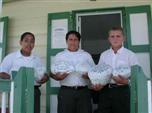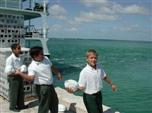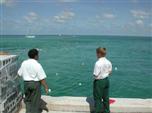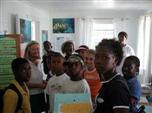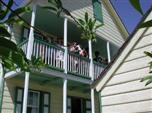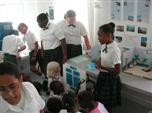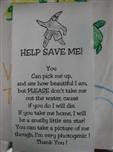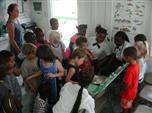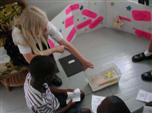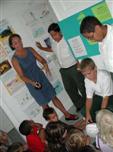

Science Fair Image Gallery - May 28, 2004
Bahamas Science Fair 2004

If the biota, in the course of aeons, has built something we like but do not understand, then who but a fool would discard seemingly useless parts? To keep every cog and wheel is the first precaution of intelligent tinkering. Aldo Leopold, Round River, 1993.
Reef Relief Founders.com

The three students who organized the Ocean Currents exhibit painted the coconuts white and marked them with identifying information and a telephone number, prior to casting them off the dock.
The Ocean Currents team released six painted coconuts off the dock at New Plymouth, Green Turtle Cay. Within a few hours, the current had carried one of the buoys into nearby White Sound where it was picked up and called in.
Currents from the dock at New Plymouth, Green Turtle Cay, carried the coconuts around the island, demonstrating how pollution from the land can be carried by the currents to offshore areas of the coral reef ecosystem.
On Thursday, May 27, the last of several groups of Camp Abaco students visited the Capt. Roland Roberts House Environmental Center. These students were from Nassau, Bahamas. Pictured is Reef Relief's DeeVon Quirolo introducing the students to the coral reef ecosystem and endangered sea turtles.
After touring all the exhibits, the students checked out the rest of the Capt. Roberts House--here they are pictured on the back upstairs balcony overlooking the fruit trees and separate kitchen building in the back yard.
Melissa, Shanice and Sonya created the Recycling Exhibit. There were two displays---the Past and the Future. The Past showed marine debris on the beach, sea turtles entangled in line, and debris all over the beach. The Future shows a visitor enjoying the clean beach, with bins holding recycled debris.
The Sea Star team produced a flyer encouraging beach goers to avoid taking sea stars out of the water.
This project was on Ocean Currents. Three students painted six coconut shells with identifying information and asked anyone who found one to call the school. The exhibit notes that ocean currents can carry pollutants from shore out to the reef.
The Shell Project involved collecting and identifying all the many shells found at Green Turtle Cay beaches. Students watch as Crystal Levarity, Kevanna McIntosh and Ashley Smith describe the variety and names of shells to be found on Green Turtle Cay.
The Sea Star project described the various parts of sea stars. A demonstration tank showed how sea stars live in the water and die when taken out of the water.


